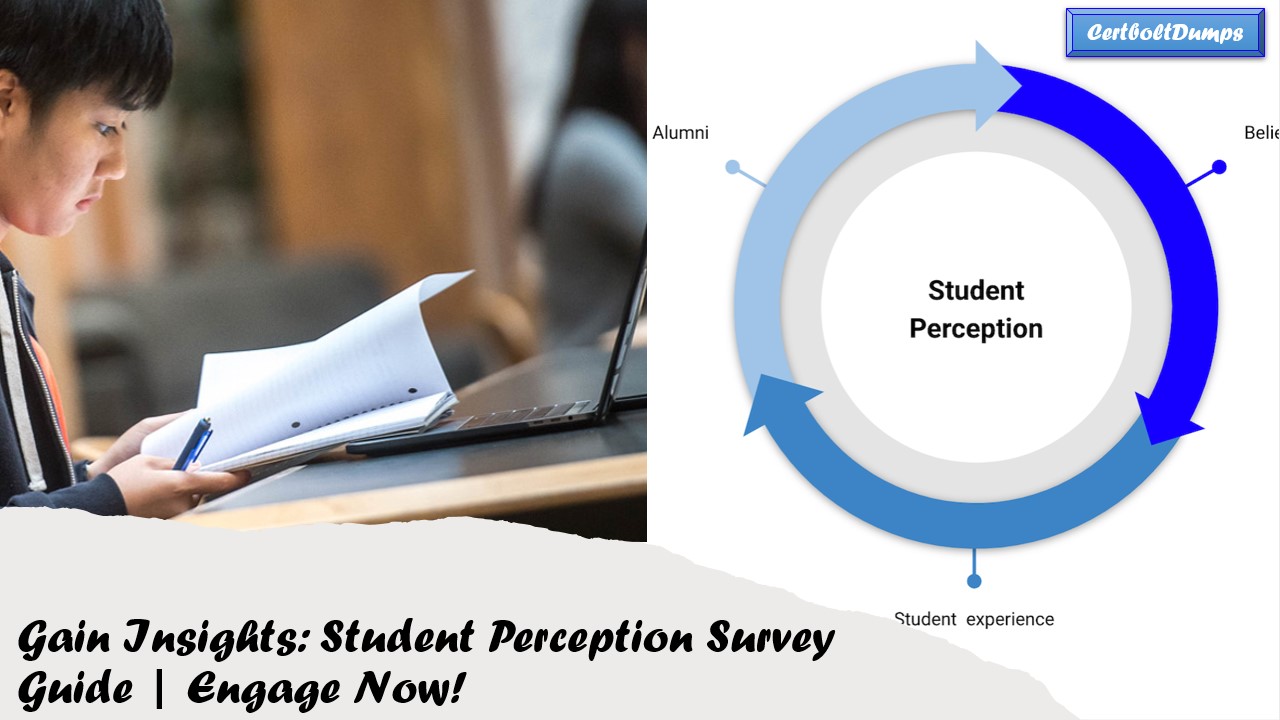Welcome to our thorough student perception survey guide! Schools must obtain student perspectives in today’s fast-paced educational environment. Creating exciting and successful educational experiences requires understanding how students perceive their learning environment and instructors.
Student perspective surveys help teachers understand students’ opinions, feelings, and experiences. These surveys offer unique opportunities to gain information that can improve classrooms and school communities.
Student Perception Survey:
Student perception surveys enable teachers and administrators to improve education, communication, and student-teacher relationships. We can make every kid feel heard, appreciated, and driven by giving them a say in their education.
In this article, we’ll discuss student perception survey question types. We will also discuss survey data analysis methods to find trends and patterns. We’ll also examine how teachers and staff may utilize these findings to create meaningful plans to increase stakeholder participation.
Let’s begin! Student perspective surveys can provide insights that can change your school community. Prepare to create an inclusive education where every kid succeeds!
Student Perception Surveys’ Goal
Student perspective surveys help schools understand students’ views, feelings, and experiences. These surveys examine student opinions on instruction, school atmosphere, and satisfaction.
Student opinion surveys let students shape their learning. Schools can better meet student needs by asking for input. This promotes student engagement and motivation by making education more student-centered.
These surveys also give instructors valuable instructional strategy and curriculum effectiveness data. Teachers might adjust their techniques by collecting student feedback. This enhances classroom experiences and academic performance.

Student impression surveys also reveal school improvement areas. These surveys show places for assistance, whether it’s bullying or extracurriculars. They help schools make educated decisions that benefit kids and the community.
These surveys also encourage open communication between administrators, teachers, staff, and students, which improves school culture. All stakeholders gain trust by offering their ideas through anonymous survey replies or focus group talks based on survey results.
Student perception surveys empower students by giving them a voice in shaping their education, helping educators improve instructional strategies based on student feedback, identifying school community areas for improvement, and building positive relationships between stakeholders, which increases teacher and student engagement!
Student Perception Survey Question Types
A student impression survey should include various questions to reveal their experiences and viewpoints. Asking the appropriate questions may reveal students’ involvement, happiness with learning, and school atmosphere. Here are some critical student perception survey questions.
- Likert Scale Questions: Students assess statements (strongly agree to disagree strongly). This inquiry might consider opinions on teaching quality and support services.
- Open-ended questions let students write extensive answers. Students can openly share their ideas and contribute rich qualitative data.
- Students choose from prepared response alternatives in multiple-choice questions. They are excellent for getting particular input on extracurricular activities or school resources.
- Demographic Questions: Grade level, ethnicity, and socioeconomic status are crucial for assessing survey data across student groups.
- Scenario-based Questions: Hypothetical scenarios help students think critically about school circumstances and what they would do or expect from instructors and staff.
Your student perspective survey can collect various data that help identify school community strengths and weaknesses by including these questions.
Analyzing Results—Organizing survey data
After conducting your student impression survey, analyze the plethora of data. This stage is essential to uncovering ideas to enhance school decisions and community life.
Collect all survey replies in a single database to evaluate the results. This ensures crucial feedback is recovered. Classify the data by grade, subject, or question/topic.
Look for patterns and trends among student groups as you review the replies. Common issues or themes? What about their schooling jumps out? Pay attention to praise and opportunities for improvement.
Use charts, graphs, and visualizations to visualize data. These graphics assist stakeholders in understanding important insights and prioritizing actions.
Analyzing survey findings requires both quantitative and qualitative comments! Note student comments and recommendations, which give essential context for quantitative responses.
Schools can acquire valuable student perception insights by adequately assessing and arranging survey data. These insights help teachers and administrators make educated decisions about how to boost school community participation!
Don’t squander those valuable survey responses—dig into your data immediately!
Tips for Results Administration and Analysis
A student perception survey must be administered and analyzed to provide relevant information. Here are some recommendations to assist you through this.
- If students know their criticism will be anonymous, they may be more honest. Assure them that their opinions count and that their identities will be kept private.
- Use simple, succinct language: Make survey questions comprehensible for all pupils. Avoid confusing phrasing that might confuse.
- Allow students to respond to questions using Likert scales or multiple-choice forms. More nuanced student views and more straightforward data analysis are possible.
- Gather more context: Ask open-ended questions or leave comment areas for students to elaborate on their replies. Qualitative insights help contextualize and improve quantitative data.
- After collecting survey responses, arrange the data for analysis. Spreadsheets or survey analysis software can aid with this.
- Regularly administering student perception surveys lets you follow student opinion trends. Comparisons across periods might provide areas for improvement or quantify strategy effectiveness.
Administering and interpreting a student perception survey requires careful organization and attention to detail, but the results can inspire good change in your school community.
Using Student Perception Survey Results to Increase Engagement
Using student perception survey results helps enhance school community participation. Use this data to improve things in these ways:
- Find areas for improvement: Analyzing survey responses might reveal areas where students are disengaged or unhappy. This might include curriculum, instructional techniques, extracurriculars, or facilities.
- Take focused action: After identifying these areas, act. Work with teachers and staff to address student issues using ideas and action plans. This proactive approach teaches students that their feedback is valued and may improve learning.
- Tailor instruction: Use survey data to understand how various student groups see learning. This information can help teachers adjust their lessons to all students’ requirements.
- Improve communication: The survey results may reveal ways to improve communication between administrators, instructors, parents, and students. Communicating with students and asking for their feedback on school topics fosters ownership and involvement.
- Support professional development: Student surveys can give feedback on instructor performance and indicate faculty team professional development requirements.
Knowing which teaching methods students prefer helps instructors improve. Schools may increase student and staff engagement and satisfaction by using student opinion surveys.
EMBRACE STUDENT-CENTERED LEARNING TODAY!
Working with teachers and staff to create action plans
Translating student perception survey findings into action requires collaboration. Schools can build action plans to enhance student-identified areas by including teachers and staff.
First, recruit a team of motivated people who want to improve student education. This team should comprise administrators, instructors, support workers, and student representatives. Involving all stakeholders ensures a holistic strategy that considers diverse viewpoints and skills.
The team should evaluate survey data after assembling. Find data themes and patterns. Do students routinely feel less engaged or supported in specific areas? These insights will direct your conversations and prioritize urgent issues.
Next, think of ways to fix these difficulties. Team members’ feedback helps solve problems, thus encouraging open communication. This collaborative method gives educators ownership and enables them to improve their classrooms.
After brainstorming, prioritize ideas by practicality and effect. Create action plans containing goals, deadlines, and roles for implementation teams.
But continue! Communicate with team members to track progress toward these targets. Maintain open contact with instructors so they may provide feedback on successful tactics and necessary revisions.
Schools may promote student engagement and build a culture of continuous improvement by working with teachers and staff, from survey data to focused interventions.
Student attitude surveys reveal how our education system might serve its most crucial stakeholders better. By acting and working with teachers and staff, we can make permanent changes that help students succeed.
Bottom Line: Student Perception Surveys Impact School Communities

Student impression surveys might transform classrooms. These surveys let students communicate their thoughts, feelings, and ideas, helping schools increase engagement and learning.
Student impression surveys can reveal trends, areas for development, and school accomplishments when given and assessed correctly. The data can inform curriculum, teacher training, classroom management, and school policy decisions.
Schools can collaborate on student challenges by incorporating teachers and staff in survey analysis. This partnership fosters openness between students and staff and a shared responsibility for educational improvement.
Engagement must be increased by acting on survey results. They are proactive, identifying issues and creating action plans to fix them. Students, teachers, and administrators should contribute to these plans to adopt complete solutions.
Student impression surveys affect the whole school community, not just classes. When students feel heard and valued through surveys, implementation efforts address their issues and strengthen peer, teacher, and staff relationships.
Student impression surveys may make schools inclusive and voice-rich. They increase teaching techniques and student-teacher communication.
Prioritizing student input through perception surveys shows institutions’ commitment to excellent learning. This dedication builds community trust and promotes academic, personal, and professional success.
Start discovering insights immediately by using student impression surveys in your school.
Listen carefully, act meaningfully, and watch engagement rise. We can improve our children’s and schools’ futures together.